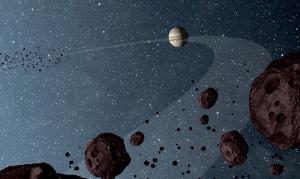Blog
Awkward Visitor
27 May 2018
 JPL-Caltech/NASA
JPL-Caltech/NASAAsteroids are small, rocky bodies that orbit the Sun. While most of them generally orbit in the region between Mars and Jupiter known as the asteroid belt, there are many exceptions. For example, there are thousands of asteroids that lie near the orbit of Jupiter. Most of these are co-orbital asteroids, meaning that they orbit the Sun with about the same orbital period of Jupiter (about 12 Earth years). These co-orbital asteroids are pushed and pulled by Jupiter’s strong gravity, keeping them in resonance with the giant planet.
Asteroids and planets usually orbit the Sun in the same direction. That’s because as the Sun and solar system formed, its gas and dust had an overall rotation, creating what is known as the invariable plane. While not everything in the solar system orbits close to the invariable plane, most solar system bodies do on average. But occasionally an asteroid or comet will orbit in the opposite direction, known as a retrograde orbit. This is usually caused by a collision or close interaction with a planet, which throws the asteroid in the odd direction. Because retrograde asteroids are orbiting opposite to almost everything else in the solar system, their orbits tend to be unstable over geologic time.
Recently, two astronomers discovered a retrograde asteroid that is also co-orbital with Jupiter.1 This is really unusualy, since co-orbital asteroids tend to be shephered into their orbits gradually over time, while retrograde asteroids tend to have been given their orbits by strong sudden events. So the team ran computer simulations to see just how stable the asteroid’ orbit is. They found that it has been stable for billions of years. That means if it was thrown into a retrograde orbit by a gravitational interaction, the event must have happened when the solar system was quite young, and it must have been extraordinarily fortunate to have been thrown into such a stable orbit.
But there is an alternative. It’s possible that the asteroid didn’t form in our solar system. Instead, it could have come from another solar system, entering our solar system in a retrograde direction billions of years ago. Over time its orbit then became resonant with Jupiter. That might have seemed like a crazy idea a couple years ago, but last year an asteroid from another solar system passed through the inner solar system, confirming that extra-solar asteroids do visit our solar system.
At this point there is no way to confirm which model is correct. The odds are against a rare event moving an astroid into such a stable retrograde orbit, but it’s not impossible. And we don’t yet know how often alien asteroids visit our solar system. Either way, it is a very unusual asteroid.
F. Namouni and M.H.M. Morais. “An interstellar origin for Jupiter’s retrograde co-orbital asteroid.” Monthly Notices of the Royal Astronomical Society Letters, 2018 doi:10.1093/mnrasl/sly057. ↩︎